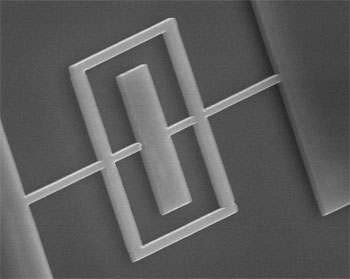| Posted: August 22, 2007 |
Watching an object go quantum |
|
(Nanowerk News) Build a pendulum small enough, and it will violate Newton's classical laws of mechanics, following quantum rules instead. Some researchers hope to observe such violations by cooling a tiny wobbling object to very low temperatures. A team of theorists has now analyzed a vibrating bar, both classically and quantum mechanically, and predicted the signatures of quantum behavior that experimenters might observe, as they report in the 27 July Physical Review Letters ("Signatures for a Classical to Quantum Transition of a Driven Nonlinear Nanomechanical Resonator"). What's more, the team found that such a classical-to-quantum transition is within reach of current technology. They hope that experiments on small moving objects will soon shed light on a deep question: why do large objects obey classical laws?
|
|
Quantum mechanical objects like atoms can act as waves and exhibit other bizarre behaviors, but large objects don't. Researchers have seen a transition from classical to quantum behavior in some kinds of experiments with larger-than-atomic objects, such as electric currents in tiny wire loops. But they haven't seen it in so-called mechanical systems, where a solid object vibrates or wobbles, except for a single controversial result in 2005 ("Evidence for Quantized Displacement in Macroscopic Nanomechanical Oscillators").
|
 |
| Nano-see-saw. The frame and paddle of this several-micron-wide mechanical resonator can oscillate by rotating about the central nanowire. A much smaller resonator made of just a wire could display quantum behaviors if cooled to 10 millikelvin, according to calculations. (Image: Physical Review Focus)
|
|
Most physicists believe that a large object behaves classically because it constantly interacts with its environment. Sufficiently cooling a small object should reduce this interaction and reveal its quantum behavior. But some researchers, including Roger Penrose of Oxford University in England, believe that even isolated objects with too much mass will behave classically, thanks to an obscure gravitational effect [2]. The Penrose idea can be tested by observing a small and cold vibrating bar, says Ron Lifshitz of Tel Aviv University in Israel. If quantum behavior doesn't show up when the bar is cooled below the temperature predicted by conventional quantum mechanics, then Penrose could be right.
|
|
When looking for quantum effects in vibrating objects, "most researchers are trying to go directly for holy grails," says Lifshitz. They're looking for exotic effects that might not be observable for years, he says. Instead, his team simply calculated the first signatures of a transition from classical to quantum behavior as the mass and temperature of a vibrating object decrease.
|
|
The researchers considered a suspended elastic beam, or nanowire, that is held at both ends and is given periodic pushes by an outside source. The nanowire is a so-called nonlinear resonator and behaves somewhat differently from an ordinary oscillating spring or pendulum. For example, classically, it usually oscillates at one of two amplitudes, depending on initial conditions. The team calculated the behavior of the resonator, according to both classical and quantum laws, for three different situations: a resonator isolated from the environment, a resonator in contact with an environment at absolute zero temperature, and a resonator in contact with an environment at a low temperature.
|
|
For the low temperature case, the researchers chose a temperature at which the classical resonator is restricted to the two states of motion and cannot switch between them. They found that according to quantum rules the resonator can spontaneously switch states or occupy states in between. Experimentalists cooling the resonator could watch for changes in the oscillation amplitude--a clear sign of a transition to quantum behavior.
|
|
According to the study, a nanowire with a mass of about 10-21 kilograms will show signs of the transition at a temperature of about 10 millikelvin. Lifshitz expects the results to be verified in the next few years.
|
|
Although the prospect of observing quantum signatures in a nanomechanical system is exciting to Miles Blencowe of Dartmouth University in Hanover, New Hampshire, he says it will be difficult. "After all, we have yet to observe a genuine quantum signature of any larger than molecular mechanical system." On the other hand, if it works, says Blencowe, "then we will be a little more certain that quantum mechanics extends up to the macroscopic domain."
|

